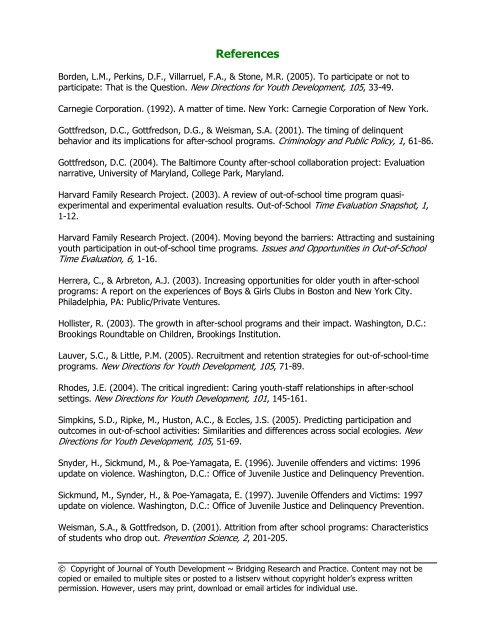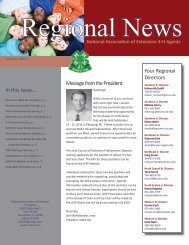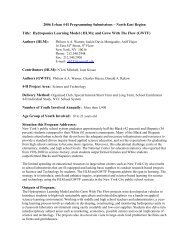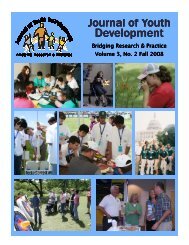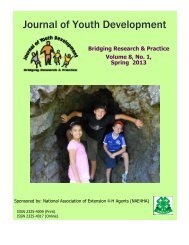The non-family-related activities that some <strong>of</strong> the dropouts participated in were dance clubs ororganized sports clubs where they would practice the same routine for one, two, or three hourseach day. At least for the dropouts in this category, these other after-school activities tookprecedence over the ASP. These structured monotonous activities were simply more “fun” and“interesting” than the unstructured, monotonous activities <strong>of</strong>fered at the ASP. Again, it may bebeneficial for program implementers to <strong>of</strong>fer a narrow set <strong>of</strong> gender- and age-specific activitieswith clearly stated purposes and goals. This may decrease the number <strong>of</strong> students in aparticular ASP, but help increase retention and engagement rates at the ASP. Tied closely tothis issue is the fourth highest reason for non-participation: program length. When studentsare bored and uninterested, program length becomes a problem. When students are engagedand excited to be present, program length is less <strong>of</strong> a problem.Eighteen percent <strong>of</strong> the dropouts in this study cited family-related after-school activities as abarrier to participation. Some students routinely watched their siblings after school, performedbasic household chores, and/or spent time with a parent in a different household after school.For program implementers, these family-related after-school activities may be harder obstaclesto overcome. However, when program implementers have some knowledge about anadolescent’s commitments outside <strong>of</strong> the program, it should help them design programs thatwork around an adolescent’s schedule. For example, some ASPs use “drop in” programs andactivities with flexible schedules as recruitment and retention strategies for older youth whomay have more demands on their time.Finally, from this research, there is no indication that students were unwilling to participate inthe academically-oriented activities at the ASP. Even the students who claimed that theacademically-oriented components <strong>of</strong> the ASP were “boring,” cited a few other reasons such asinvolvement in “other after-school activities” as the main barrier to participation. However, thisstudy did find that some dropouts felt that there was a lack <strong>of</strong> quality academic help. Theresults imply that it is imperative that tutors, program staff, and helpers be knowledgeable inthe student’s coursework, especially in the particularly difficult areas <strong>of</strong> math, reading, andlanguage arts. It may be beneficial to do one <strong>of</strong> two things: either conduct an assessment <strong>of</strong>the student’s math, reading, history, language arts (and other subjects) skills and find outwhere the majority <strong>of</strong> the students are struggling, or access their student records in order todetermine the areas that need improvement. Perhaps this manner <strong>of</strong> addressing academicconcerns will help program implementers in the hiring process and help give students the toolsthey need to improve their academic skills and further their academic success.Recommendations for Future StudiesFuture studies may want to take into consideration the challenges recognized in this study asthey seek to develop after-school programming that suits the unpredictable needs <strong>of</strong> studentsand their families.
ReferencesBorden, L.M., Perkins, D.F., Villarruel, F.A., & Stone, M.R. (2005). To participate or not toparticipate: That is the Question. New Directions for Youth Development, 105, 33-49.Carnegie Corporation. (1992). A matter <strong>of</strong> time. New York: Carnegie Corporation <strong>of</strong> New York.Gottfredson, D.C., Gottfredson, D.G., & Weisman, S.A. (2001). The timing <strong>of</strong> delinquentbehavior and its implications for after-school programs. Criminology and Public Policy, 1, 61-86.Gottfredson, D.C. (2004). The Baltimore County after-school collaboration project: Evaluationnarrative, University <strong>of</strong> Maryland, College Park, Maryland.Harvard Family Research Project. (2003). A review <strong>of</strong> out-<strong>of</strong>-school time program quasiexperimentaland experimental evaluation results. Out-<strong>of</strong>-School Time Evaluation Snapshot, 1,1-12.Harvard Family Research Project. (2004). Moving beyond the barriers: Attracting and sustainingyouth participation in out-<strong>of</strong>-school time programs. Issues and Opportunities in Out-<strong>of</strong>-SchoolTime Evaluation, 6, 1-16.Herrera, C., & Arbreton, A.J. (2003). Increasing opportunities for older youth in after-schoolprograms: A report on the experiences <strong>of</strong> Boys & Girls Clubs in Boston and New York City.Philadelphia, PA: Public/Private Ventures.Hollister, R. (2003). The growth in after-school programs and their impact. Washington, D.C.:Brookings Roundtable on Children, Brookings Institution.Lauver, S.C., & Little, P.M. (2005). Recruitment and retention strategies for out-<strong>of</strong>-school-timeprograms. New Directions for Youth Development, 105, 71-89.Rhodes, J.E. (2004). The critical ingredient: Caring youth-staff relationships in after-schoolsettings. New Directions for Youth Development, 101, 145-161.Simpkins, S.D., Ripke, M., Huston, A.C., & Eccles, J.S. (2005). Predicting participation andoutcomes in out-<strong>of</strong>-school activities: Similarities and differences across social ecologies. NewDirections for Youth Development, 105, 51-69.Snyder, H., Sickmund, M., & Poe-Yamagata, E. (1996). Juvenile <strong>of</strong>fenders and victims: 1996update on violence. Washington, D.C.: Office <strong>of</strong> Juvenile Justice and Delinquency Prevention.Sickmund, M., Synder, H., & Poe-Yamagata, E. (1997). Juvenile Offenders and Victims: 1997update on violence. Washington, D.C.: Office <strong>of</strong> Juvenile Justice and Delinquency Prevention.Weisman, S.A., & Gottfredson, D. (2001). Attrition from after school programs: Characteristics<strong>of</strong> students who drop out. Prevention Science, 2, 201-205.© Copyright <strong>of</strong> Journal <strong>of</strong> Youth Development ~ Bridging Research and Practice. Content may not becopied or emailed to multiple sites or posted to a listserv without copyright holder’s express writtenpermission. However, users may print, download or email articles for individual use.
- Page 2 and 3:
Winter 2008Volume 3 Number 3Editor
- Page 5:
Examining the Potential Unintended
- Page 8 and 9:
centered, multidisciplinary approac
- Page 10 and 11:
Volume 3, Number 3, Winter 2008Arti
- Page 12 and 13:
fostering skill learning and positi
- Page 14 and 15:
Table 1Participation in out-of-scho
- Page 16 and 17:
ResultsOur analyses were conducted
- Page 18 and 19:
watching TV, playing video games or
- Page 20 and 21:
Accordingly, this research augments
- Page 22 and 23:
Dotterer, A.M., McHale, S.M., & Cro
- Page 24 and 25:
A Descriptive View of the 4-H Club
- Page 26 and 27:
In this paper, the results of a cro
- Page 28 and 29:
section is a set of statements that
- Page 30 and 31:
Table 3Experience in the 4-H clubNo
- Page 32 and 33:
significantly higher than Caucasian
- Page 34 and 35:
p
- Page 36 and 37:
This study focused only on the 4-H
- Page 38 and 39:
Theokas, C., Lerner, J.V., Phelps,
- Page 40 and 41:
Volume 3, Number 3, Winter 2008Arti
- Page 42 and 43:
potential for reaching audiences, d
- Page 44 and 45:
Putting Marketing Concepts into Pra
- Page 46 and 47:
2. Find out what others think about
- Page 48 and 49:
Diem, K.G. (1994). What do youth li
- Page 50 and 51:
Promoting Supportive Relationships
- Page 52 and 53:
focused on youth-adult relationship
- Page 54 and 55:
Conversely, more modern educational
- Page 56 and 57:
perhaps most importantly, the effic
- Page 58 and 59:
Organized youth programs, when stru
- Page 60 and 61:
likely to internalize the positive
- Page 62 and 63:
Ellis, J.M., & Caldwell, L.L. (2005
- Page 64 and 65:
Schweinle, A., Meyer, D.K., & Turne
- Page 66 and 67:
Volume 3, Number 3, Winter 2008Arti
- Page 68 and 69:
This study uses the “5 Cs” mode
- Page 70 and 71:
ResultsIn this analysis 48 codes we
- Page 72 and 73:
Table 3Inductive Codes Classified b
- Page 74 and 75:
CompetenceCompetence in organized s
- Page 76 and 77:
ecause of him (the coach)…. You d
- Page 78 and 79:
practices and competitions, the gir
- Page 80 and 81:
Eccles, J.S., & Gootmann, J.A. (Eds
- Page 82 and 83:
Smoll, F.L., & Smith, R.E. (2002).
- Page 84 and 85:
Volume 3, Number 3, Winter 2008Arti
- Page 86 and 87:
The present work builds upon that o
- Page 88 and 89:
MethodSample and Data CollectionAs
- Page 90 and 91: (scores ranging from 0 to 8) and a
- Page 92 and 93: Table 2Paired Sample T-tests Compar
- Page 94 and 95: Hypotheses 5 and 6 were tested by c
- Page 96 and 97: De Coverly Veale, D.M.W. (1987). Ex
- Page 98 and 99: Story, M., Neumark-Sztainer, D., Sh
- Page 100 and 101: Volume 3, Number 3, Winter 2008Arti
- Page 102 and 103: Cronbach’s Alpha Score For Youth
- Page 104 and 105: 12 to 18 years old. Fourteen of the
- Page 106 and 107: Therefore, there was a mixed relati
- Page 108 and 109: Youth respondents identified two ob
- Page 110 and 111: are developed through working in a
- Page 112 and 113: Seevers, B.S., & Dormody, T.J. (199
- Page 114 and 115: Volume 3, Number 3, Winter 2008Arti
- Page 116 and 117: With the many opportunities that yo
- Page 118 and 119: meaningfully reduced involving dedu
- Page 120 and 121: StaffingXTime/Schedule X X XTrainin
- Page 122 and 123: “Involving adults that will allow
- Page 124 and 125: “They can't drive or do not have
- Page 126 and 127: page in understanding why youth voi
- Page 128 and 129: Parker, L. (1999). If all youth ser
- Page 130 and 131: Volume 3, Number 3, Winter 2008Arti
- Page 132 and 133: However, the literature is mixed in
- Page 134 and 135: group was the quality of the progra
- Page 136 and 137: Table 1Reasons for Non-Attendance:
- Page 138 and 139: easons given was six. Sixty-three p
- Page 142 and 143: “Catch ‘Em Being Good:”An Ext
- Page 144 and 145: In 2001, the WVUES received a schoo
- Page 146 and 147: to leverage the resources of the co
- Page 148 and 149: 4. Most primary behavior incidents
- Page 150 and 151: Recommendations for developing prog
- Page 152 and 153: Cross-Cultural UnderstandingThrough
- Page 154 and 155: that plague these nations such as p
- Page 156 and 157: 2003). Youth leadership training in
- Page 158 and 159: • enable these young people to pa
- Page 160 and 161: We believe that the USPORT program
- Page 162 and 163: West Virginia’s Response to theRo
- Page 164 and 165: Ensuring good oral health requires
- Page 166 and 167: Table 1Correlations between Planner
- Page 168 and 169: problems in this rural state…This
- Page 170 and 171: Volume 3, Number 3, Winter 2008Arti
- Page 172 and 173: vacuum. Determination of factors, a
- Page 174 and 175: ReferencesBaldwin, C., & Caldwell,
- Page 176 and 177: Volume 3, Number 3, Winter 2008Arti
- Page 178 and 179: Purpose of StudyThe purpose of this
- Page 180 and 181: Students in the High computer gamin
- Page 182 and 183: Do Higher Levels of 4-H LeadershipA
- Page 184 and 185: IntroductionEmotional Intelligence
- Page 186 and 187: second section examined demographic
- Page 188 and 189: a constructive manner. The group is
- Page 190 and 191:
differences in the scores for the 1
- Page 192 and 193:
Adaptability include “Reality Tes
- Page 194 and 195:
ReferencesAmerican Academy of Pedia
- Page 196 and 197:
Healthy Kids, Healthy Families:A Co
- Page 198 and 199:
and a half million U.S. youth (ages
- Page 200 and 201:
Families. In partnering counties, p
- Page 202 and 203:
Healthy Families was then offered a
- Page 204 and 205:
Kamberelis, G., & Dimitriadis, G. (
- Page 206 and 207:
Volume 3, Number 3, Winter 2008Arti
- Page 208 and 209:
Change It Up!What Girls Say About R
- Page 210:
In addition, the study summarizes t


